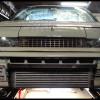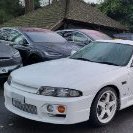Different Highflow Characteristics
Announcements
-
Similar Content
-
Latest Posts
-
..this is the current state of that port. I appreciate the info help (and the link to the Earls thing @Duncan). Though going by that it seems like 1/4 then BSP'ing it and using a bush may work. I don't know where I'd be remote mounting the pressure sender... to... exactly. I assume the idea here is that any vibration is taken up by the semiflexible/flexible hose itself instead of it leveraging against the block directly. I want to believe a stronger, steel bush/adapter would work, but I don't know if that is engineeringly sound or just wishful thinking given the stupendous implications of a leak/failure in this spot. What are the real world risks of dissimilar metals here? It's a 6061 Aluminum block, and I'm talking brass or steel or SS adapters/things.
-
And if you have to drill the oil block, then just drill it for 1/4" and tap it BSP and get a 1/8 to 1/4 BSP bush. The Nissan sender will go straight in and the bush will suit the newly tapped hole. And it will be real strong, to boot.
-
No it doesn't. It just needs an ezy-out to pull that broken bit of alloy out of the hole and presto chango - it will be back to being a 1/8" hole tapped NPT. as per @MBS206 recco. That would be for making what you had in alloy, in steel. If you wanted to do just that instead of remote mounting like @Duncan and I have been pushing. A steel fitting would be unbreakable (compared to that tragically skinny little alloy adapter). But remote mounting would almost certainly be 10x better. Small engineering shops abound all over the place. A lathe and 10 minutes of time = 2x six packs.
-
Ahh. Well the block damage is a problem, you really need to run a tap or thread chaser through it to see if the threads can be saved, but any chips are likely to be bottom end bound which is bad. Earls seem to have what you need if you want to stick with mounting direct on the block: https://rceperformance.com.au/parts/earls-straight-adapter-1-8-npt-male-to-1-8-bspt-female.html, but as I said above I'd recommend remote mounting the sender
-
I'm not quite understanding or I'm missing steps here, (I appreciate people are trying to inform my brain but I am of the dumb, especially today) - All I want to do is mount the male BSPT of the OEM sender into the system somewhere without it snapping the adapter via vibration. The Nissan sender has a male 1/8 BSPT output. The block has a (very destroyed) 1/8 NPT input. I'm not really sure how a lathe assists with that, and also don't know anybody with a lathe, nor specifically what I would want to buy. I'm not really sure how adding additional adapters creates a better, more leak proof resilient seal here.
-





Recommended Posts
Create an account or sign in to comment
You need to be a member in order to leave a comment
Create an account
Sign up for a new account in our community. It's easy!
Register a new accountSign in
Already have an account? Sign in here.
Sign In Now